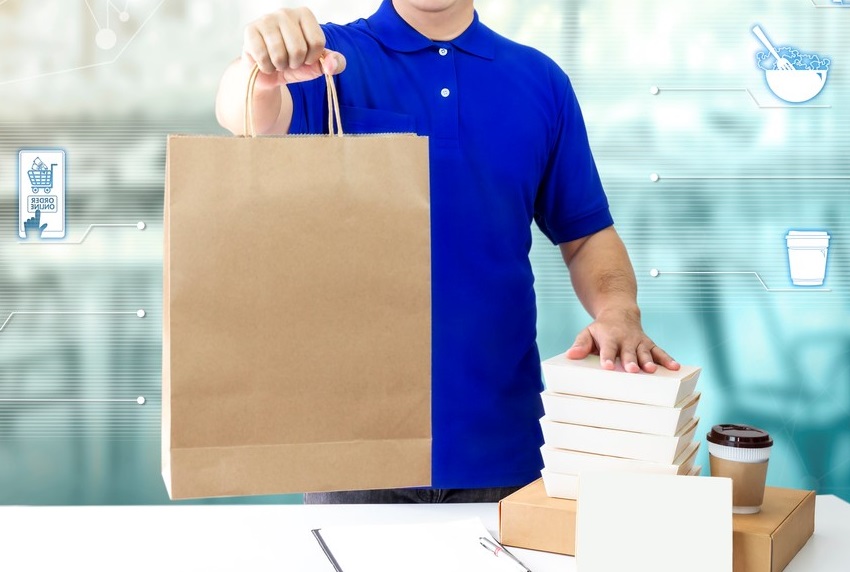Article
QSR Conundrums: Taming that booming 'order-online, pickup in-store' business
In this first of a new QSRweb bimonthly series, QSR Conundrums, our experts give their best thoughts on new ways to handle a relatively new "problem" of increasing buy-online/pickup in-store business, a segment of restaurant industry business growing at four times the rate of delivery business.

November 26, 2019 by S.A. Whitehead — Food Editor, Net World Media Group
QSR conundrums: All quick-service brands have them, but they seem to be coming more quickly these days when ever-improving restaurant tech is constantly changing the game. That's one reason this month, QSRweb begins a alternating-month series that we hope operators will both read and contribute to, all under that very heading of "QSR Conundrums."
Every other month, we'll feature a new quick-service operational challenge that brands suggest or we uncover in our daily duties reporting on the industry. We're starting this month with a "conundrum" highlighted during recent QSRweb coverage around a Rakuten Ready study that found quick-service brands are showing "deep gaps in customer experience across categories for both in-store and curbside pickup."
 |
| Photo: iStock. |
In that analysis of some 750 secret-shopper orders placed online and picked up in store at 25 QSR brands and other retailers, big problems were uncovered around QSRs not having orders ready for pickup, as well as lacking dedicated dedicated pickup areas or even pickup lines in their stores.
The result? That restaurant industry toxin we all know as the angry, upset and in all other ways, perturbed patron, along with the cruddy reviews, nasty online chatter and all around injurious word-of-mouth that collectively act like a giant sponge that sucks orders and profits away from the offending brands.
Perhaps somewhat oddly, the slower service category of fast casual appeared to have more brands that showed some level of mastery in accommodating this segment of business in the study findings, with particularly good results at fast casuals like Panera and Chipotle.
Strict QSRs or fast food brand, on the other hand, struggled to keep up, perhaps partly because of the increased customer expectation for quicker service that the QSR category name implies.
But the idea behind the QSR Conundrums series is not to belabor problems, but to put forth some solutions. In that realm, we found a number of industry experts with interesting thoughts on different approaches to building better BOPIS — as in Buy-Online, Pickup-In-Store — business for QSRs.
5 best practices to a perfect 'pickup-in-store' experience
The study's sponsor, Rakuten Ready, was one of the experts we spoke with for answers, including the one you might expect: The company would like it if all QSRs used the firm's predictive arrival technology, Arrive, to get a handle on BOPIS business.
 |
Rakuten Ready CEO Jaron Waldman (Photo provided). |
Beyond that, Rakuten Ready CEO Jaron Waldman also had a lot of great suggestions on ways the company's study found that those who do succeed in this realm actually do it. He said the time is right for such action, since currently order-for-pickup is growing four times faster than delivery for QSRs (57% CAGR vs 13% CAGR).
In that business setting, QSRs that do nothing operationally to adjust to this new demand face near-assured risks of an increasingly unpleasant customer experience thanks to the rising consumer demand creating inefficiencies and operational bottlenecks that not only wreak havoc on dine-in patrons, but also keep BOPIS customers waiting for orders often of reduced quality.
Waldman said with the vast majority (73%) of restaurant customers relaying that "brand experience" was the top factor in their restaurant choice decisions — behind both value and product quality, according to the 2018 PwC Future of Customer Experience Survey 2018 — the importance of getting this sector of business right is clear.
Based on (Rakuten Ready's) study, here are five best practices that can help QSRs optimize operational processes and deliver a winning customer experience:
- Optimize technology to manage throughput and quality while driving lower costs and increased revenue.
- Prioritize low customer wait-times by using data to uncover areas that need improvement.
- Focus on logistics and infrastructure, including clear signage and dedicated pickup lines that help cut wait-time and improve customer experience.
- Provide dedicated employee training so frontline staff feel confident firing orders at the best times and ensuring all are delivered at peak quality.
- Promote programs with dedicated marketing campaigns to raise awareness, drive traffic and produce useful performance data.
"Brands need to continually evaluate and evolve the end-to-end experience at every step of the customer journey," Waldman said in an interview with QSRweb. "This requires going beyond traditional infrastructure, processes and capabilities to find innovative solutions that solve for the rapid growth happening today in the highly competitive on-demand economy."
Does it all ultimately pay off for brands though? Well, Rakuten's data also showed that customers with an under two-minute wait for their orders were four times more likely to return to the well-performing brand regularly. Still, only a very few brands and only fast casuals hit that benchmark in the Rakuten Ready study.
'Flow' knows best
One area that many QSRs are investigating or currently making changes to in order to handle this segment of business is in their physical store and make-line designs. Dedicated pickup areas, exclusive mobile order pickup lines and separate prep lines for mobile orders are all showing promise for helping brands tackle both in-store and online orders for pickup.
 |
Dyer Brown President and Director of Design Brent Zeigler (Photo provided). |
That's why we also sought the input of restaurant designers on ways they're dealing with this increasing restaurant operator need. At Boston, Massachusetts-based, Dyer Brown, president and director of design, Brent Zeigler, said they see this need increasing daily.
"More and more often we are working with clients whose venues depend on a mix of dine-in and takeout patronage, both revenue streams being equally vital to long-term success," Zeigler told QSRweb.
"To maximize performance for both and strike the right balance between the two, it is critical to optimize traffic flow in ways that will enhance the visit experience for takeout customers, while not negatively impacting the experience of dine-in customers. For more than one client we have produced designs that encourage takeout patrons to spend more time in the venue waiting."
Zeigler pointed to the solution his company was able to implement with a pizza restaurant business experiencing increasing order-online, pickup in-store business. In fact, the solution the company came up with really heightened the experience of waiting customers.
"For one pizzeria-style restaurant, for example, we arrived at a program that enhances staff coordination around the kitchen and bar while optimizing traffic flow and customer experience with a comfortable, welcoming circulation route for takeout customers that prevents crowding the bar area or obstructing service flow from kitchen," he said.
"The design also introduced an advantageous solution for supplementing the bar seating with upholstered banquettes along (the) takeout circulation route. Specifically designed with takeout customers in mind, the banquette seats include small on-board tables — perfect for playing a game or, better still, for enjoying a drink or an appetizer — realizing incremental revenue for the owners.
"Meanwhile, the robust takeout operation is in harmony with the comfortable, intimate dine-in experience located throughout the venue, whether in the central seating area or in 'vignette' dining zones. The brand-focused concept also provides everyone — whether there for takeout or dine-in —a view of the 'action' (in) the pizza oven at the heart of the operation."
'It's in the bag' ... er locker
 |
Haven Foods Director and Executive Chef Suzannah Gerber (Photo provided). |
At Haven Foods, director, executive chef and East Coast restaurant consultant, Suzannah Gerber, said that many of the brand she deals with also are struggling with this issue. Though she said each brand will always have different priorities, she was able to develop some basic idea that can help all brands. Included among those ideas are telling brands to think about investing in temperature-holding catering gear.
"If you use your own drivers, load foods into insulated delivery bags and hold them in thermal cambros (one cold, one hot) until pickup to maximize temp hold and reduce heat transfer on the items themselves," Gerber said. "When using a delivery service, consider an insulated pickup area, such as a shelf labeled by service (GrubHub, Uber, Door Dash etc) with each (third-party provider having) their own Cambro. Then it will be up to the service to provide insulated carry bags."
On the topic of insulated pickup areas, one of the leaders in food storage lockers to the restaurant industry also chimed in with some solutions pertaining to this topic. In fact, Apex Supply Chain Technologies already provides heated storage lockers to a number of QSRs, like Little Caesars along with stadiums and theaters nationally.
"The quest to find the right solution to these challenges is a popular topic of conversation in every show, panel and association in the industry," Apex Supply Chain Technologies Vice President of Global Marketing Kimberly Carroll said.
"Strategies range from tamper-proof packaging ... to incorporating new features or functions into their mobile apps, such as order pickup scheduling to assist operations with planning and preparation schedules. ...
"Technology and equipment options, such as smart lockers are ... intelligent systems (that) can be heated, chilled or ambient, and allow third-party delivery services and customers to pickup from the same system. Some solutions even allow customized configurations for lighting, holding time, temperature settings and more.
"Orders come into the restaurant via the many different methods. Operators make the order based on the pickup time provided and customers/pickup services are notified with a secure pickup code as soon as the order is ready. Pick-up happens in seconds by scanning or entering the secure code, which opens the compartment containing the order. The customer ... takes the order and can easily be on their way."
Tech as in-store pickup tamer
Tillster CMO Hope Neiman also believes the answer to this operational challenge that in many ways technology created as also
 |
Tillster CMO Hope Neiman (Photo provided). |
being within technology in many respects. As she said in an interview with this website, it may take some investment but the potential benefits promise to be particularly profitable for brands that partake.
"For QSRs that put the right technology in place to meet shifting customer expectations, the benefits can mean real advances for the brand," she said. "Brands should move toward a singular customer record, which is key in creating a positive customer experience and improving efficiency.
"QSRs can also automate email messages, push notifications and texts to target specific actions from various subgroups and categories of visitors. In each case, whether targeting the most loyal or the most occasional of customer, QSR brands can use the real-world data of their visitors to drive increases in frequency and order size. ... The question is no longer whether a brand should offer digital ordering, but how it should be optimized to meet both business goals and customers' needs."
Does your QSR have a "conundrum" that this series can research and find possible solutions for? Send an email to QSRweb Editor Shelly Whitehead at editor@qsrweb.com, including whether you prefer to remain anonymous as the conundrum-contributing brand or get a little publicity for your QSR in the feature if we decide to chase down answers to your operational stumper.
About S.A. Whitehead
Pizza Marketplace and QSRweb editor Shelly Whitehead is a former newspaper and TV reporter with an affinity for telling stories about the people and innovative thinking behind great brands.




